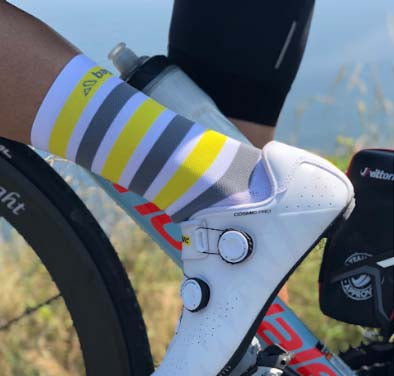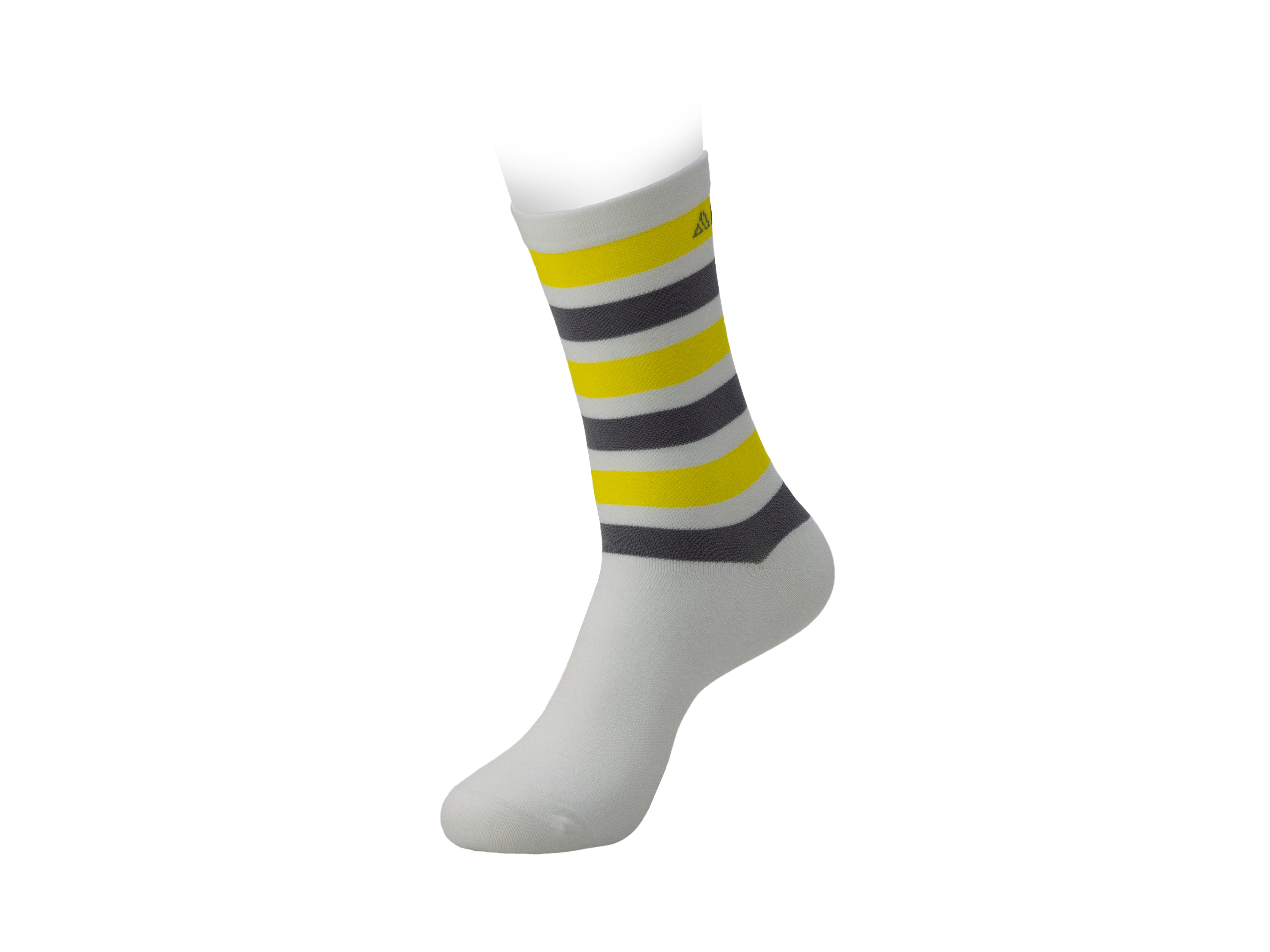#70 What does a cyclist eat during a race?
A cyclist's body is like an old-fashioned train, burning calories instead of coal, and the only thing missing is Groucho Marx shouting, "Bring on the wood, bring on the wood!" It's constantly burning energy! And despite how important it is to have a good breakfast, you need to continue getting nourishment throughout the race to be able to face a tough 4- or 5-hour stage.
To do this, cyclists have two resources: the few things they can carry in their jersey pockets (fruit, bars, some gel) and the famous cloth bag that the assistants hand out at the solid refreshment point. Today we'll look at what's in these bags and why their contents are chosen.

What do the regulations say about solid food supplies?
The first thing to keep in mind is that during a cycling stage, you cannot hand in this bag of food at any time. Each stage has a designated refreshment point, outside of which this is not permitted. The UCI sets the general rules for these issues, but it leaves each race plenty of leeway to establish its own rules.
Generally, only one refreshment point is allowed if the stage is over 150 kilometers long, although sometimes there are stages so long (such as some in the Giro) that two are permitted. This point must be after the 50th kilometer mark and before the last 20 kilometers .
In addition to these general guidelines, there are some other rules that may seem interesting. For example, during a breakaway, food may be distributed to the tail of the group, provided that the group consists of fewer than 15 cyclists . And if a race director wants to distribute solid food to a rider from the car, they may do so at any time except in the vicinity of this refreshment point (the vicinity being understood as the section 12 kilometers before or 10 kilometers after ).
What does medicine say about the need to eat while racing?
The carbohydrate reserves of an adult exercising at a medium-high intensity typically last between 90 and 120 minutes . After that, performance drops noticeably, and it's necessary to replenish them to continue (although it's not advisable to reach this point; we must be cautious and not push our bodies to the limit).
The most recommended thing is to eat foods rich in glucose or carbohydrates , but not protein. Protein helps muscle recovery, which is why it's good to consume it after exercise, but it doesn't help much during exercise, which is why we don't recommend eating foods high in protein.

What does a cyclist's bag carry?
Typically, teams aim to provide cyclists with between 1,200 and 1,500 kilocalories in each bag, almost all of which comes from carbohydrates. Each team and rider has their own habits or habits, but there are a number of foods we'll almost always find:
Fresh fruit
If there's one thing we always appreciate mid-stage, it's a piece of fresh fruit . Fruit is easy to transport and eat, offers a wide variety of flavors, and provides us with water, vitamins, minerals, natural carbohydrates in the form of fructose, and soluble fibers like pectin. One of the most popular is banana, a source of vitamin B, potassium, and magnesium. Apples and pears are also good choices.
It's best to bring the fruit already washed and cut, wrapped in plastic or aluminum foil so it's easy to eat.
The only downside is that the fiber in fruit, combined with fructose, can have a laxative effect . To avoid problems, it's best to only eat fruits that we've found to be good for us.
Dried fruits
Foods like raisins, dried apricots, dates, and dried figs are a good source of easily digestible carbohydrates, fiber, vitamins, and minerals. Their sweet flavor makes them appealing at any time and they're convenient to carry. Their only drawback is that they're high in laxative fiber .
Nuts
It's always a good idea to include a good portion of nuts in your bag, as they take up little space and provide a wealth of minerals, carbohydrates, fats, and vegetable proteins . Their only drawback is that they are slow-digesting due to their high content of vegetable fats, fiber, and vegetable proteins. If you buy them already roasted, they can be quite salty and make you feel thirsty.
A small salty roll or snack
There's a very small type of sandwich that's already a classic among food bags. It's important that they're easy to unwrap and eat on the go (the assistants are true masters of wrapping and prepare mini-sandwiches that are works of art).
They usually contain some low-fat sausage, such as cooked ham or turkey . Nothing like the chorizo sandwiches that good old Bahamontes used to eat in his day.
A sweet roll or snack
Another essential item that's always present is a small sweet snack to compensate for the loss of glucose. This usually consists of a small sandwich of jam, quince jelly, or cocoa spread .
Another option is the famous rice cakes , a cheap, tasty, and natural choice. They're usually made by the team's own chefs (or you make them yourself—they're so easy to prepare!). Mark Cavendish loves the pistachio rice cake, and the Sky Team chef prepares them in different flavors so his cyclists can enjoy a certain variety.
1 or 2 high glucose gels
Gels are a real invention and are here to stay in cycling. We can find a wide variety of brands, flavors, and compositions.
They are usually composed of slow-assimilating carbohydrates mixed with fast-assimilating glucose . Vitamins B and C are added to improve metabolism and mineral salts to replace electrolytes lost through sweat. This is the usual composition, but there are so many different types of gels on the market today that it's difficult to generalize.
Their main advantage is their convenience and easy digestion, but you should be careful and test them thoroughly during training before using them in competition. They could cause a glucose spike or digestive problems . You should drink water to ensure you assimilate them properly.
They are usually taken during moments of high intensity or a few kilometers from the finish line, to be able to face the arrival with energy.
1 or 2 energy bars
The variety of bars available on the market is immense, but generally speaking, they're high in carbohydrates (between 30 and 50 grams). They also contain beneficial fatty acids that aid digestion.
It's recommended to take a bar approximately every hour , always with a good drink of water to help you digest it. Many cyclists carry them pre-cut and can eat them slowly.
Liquids
Typically, each bag includes a water bottle and a mineral salt bottle . Sometimes a fruit drink or cola is also added because it's an instant source of caffeine and sugar and has a fairly rapid stimulating effect. But some cyclists try to avoid it because of the gas and its high glycemic index.
Gone are the days when cyclists would drink alcohol during the stage (or raid roadside bars, grabbing bottles of wine, beer, or champagne).
Some useful tips
In conclusion, we can offer you the following decalogue:
1.- Prepare your supplies with the same care with which you prepare your bike, your clothing or your physical condition. 2.- Try new things in training, but don't try to innovate in competitions; always play it safe. 3. Eat before you're hungry and drink before you're thirsty . When this happens, it's a sign that our body is already experiencing some deficiency that could affect our performance. Prevention is always better than cure. 4.- Stay hydrated . Drink plenty of water when eating solid foods to help your body digest them. 5.- Watch the quantities : falling short is as bad as going over the quantity. 6.- Do not abuse cold liquids no matter how hot it is. 7.- Take advantage of the easier sections of the route to refuel. Avoid periods of intense effort. 8.- Choose natural foods whenever you can. 9.- Consult with trusted professionals : nutritionists, doctors, and experienced cyclists will give you the best advice. 10.- Don't litter the road . Wrappers should be kept in your jersey and not thrown anywhere. The road is our environment, and we must take care of it.
And here's a bonus tip : there's nothing more satisfying than riding with the group, training hard, and stopping midday for a coffee and a snack. And where could you stash some coins or a bill so you don't lose them? In your Baggicase , the waterproof cyclist's phone case!

